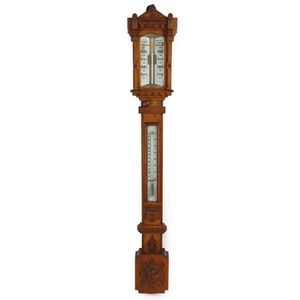Victorian Gothic Stick Barometer with Thermometer
You must be a subscriber, and be logged in to view price and dealer details.
Subscribe Now to view actual auction price for this item
When you subscribe, you have the option of setting the currency in which to display prices to $Au, $US, $NZ or Stg.
- Victorian Period - The Victorian period of furniture and decorative arts design covers the reign of Queen Victoria from 1837 to 1901. There was not one dominant style of furniture in the Victorian period. Designers used and modified many historical styles such as Gothic, Tudor, Elizabethan, English Rococo, Neoclassical and others, although use of some styles, such as English Rococo and Gothic tended to dominate the furniture manufacture of the period.
The Victorian period was preceded by the Regency and William IV periods, and followed by the Edwardian period, named for Edward VII (1841 ? 1910) who was King of the United Kingdom and the British Dominions and Emperor of India for the brief period from 1901 until his death in 1910. - Oak - Native to Europe and England, oak has been used for joinery, furniture and building since the beginning of the medieval civilisation. It is a pale yellow in colour when freshly cut and darkens with age to a mid brown colour.
Oak as a furniture timber was superceded by walnut in the 17th century, and in the 18th century by mahogany,
Semi-fossilised bog oak is black in colour, and is found in peat bogs where the trees have fallen and been preserved from decay by the bog. It is used for jewellery and small carved trinkets.
Pollard oak is taken from an oak that has been regularly pollarded, that is the upper branches have been removed at the top of the trunk, result that new branches would appear, and over time the top would become ball-like. . When harvested and sawn, the timber displays a continuous surface of knotty circles. The timber was scarce and expensive and was used in more expensive pieces of furniture in the Regency and Victorian periods.
This item has been included into following indexes:
- barometers, period or origin - Victorian period 119
- barometers, type
Visually similar items

A mid 18th century longcase thirty hour clock in repolished quarter sawn solid oak case. Bell strike. Brass face with silvered chapter ring and gilt scroll spandrels by Thomas West. C.1770, listed as working in Reading 1762-1780. Height 192 cm

A 19th century long case clock, with a painted Arabic numeral dial, and an anchor escapement on one bell, 237 cm high

George III mahogany long case clock by a Kirkwood of Paisley, the hood with octagonal columns, painted arched dial with Roman and arabic numerals and subsidiary calendar dials

An impressive Edwardian mahogany and satinwood marquetry long case clock marked Green Brothers Newcastle, circa 1900, the hood with swan neck pediment with floral bosses, the arched door flanked by reeded Corinthian columns enclosed is the brass and silver
